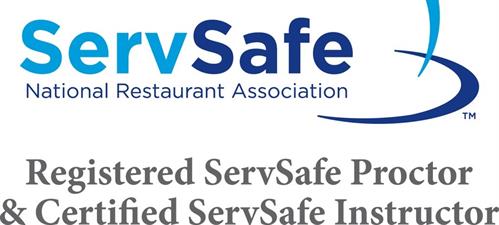Quick Tips for Successfully Completing Your ServSafe Food Handler Training Course Online
Quick Tips for Successfully Completing Your ServSafe Food Handler Training Course Online
Blog Article
Comprehensive Food Handlers Educating for Hygiene and Safety And Security
In today's rapidly developing food service landscape, detailed food handlers training has actually arised as an important element for ensuring hygiene and safety. By instilling important practices connected to hand hygiene, food storage, and hygiene, this training not just minimizes the risk of foodborne health problems yet likewise enhances conformity with regulatory standards. The implications of such training prolong beyond mere conformity; they discuss public wellness and customer trust. Yet, the effectiveness of these training programs can vary significantly. What variables truly determine their success in promoting a society of safety and security?
Value of Food Safety Training

Furthermore, food safety training helps to make certain that workers are aware of present guidelines and standards, which are necessary for maintaining functional licenses and preventing pricey penalties. Normal training sessions also function as a system for enhancing best techniques, thus minimizing the probability of human mistake, which frequently acts as a leading reason of food contamination.
Additionally, buying food safety and security training can enhance a facility's track record, as consumers progressively prioritize dining experiences that reflect high safety standards. Such proactive measures not just shield consumers however likewise contribute to the long-lasting success of food companies. In recap, thorough food safety training is an important aspect of food solution procedures, directly impacting both public wellness and organization sustainability.
Key Principles of Health
Keeping high criteria of hygiene is vital in any kind of food managing setting to stop contamination and ensure the safety and security of customers. The vital principles of health include a number of crucial techniques that food trainers need to constantly use.
First, hand health is paramount; food trainers ought to wash their hands extensively with soap and water before and after handling food, as well as after utilizing the restroom or touching any kind of possibly polluted surface areas. Second of all, equipment and surfaces should be frequently cleaned and sanitized to get rid of microorganisms. This consists of tools, reducing boards, and counter tops, which ought to be kept in a clean problem.


Proper food storage is additionally vital; raw foods should be stored individually from cooked or ready-to-eat items to avoid cross-contamination. servsafe food handler. In addition, preserving appropriate temperature level controls is important; disposable things ought to be maintained secure temperature levels to inhibit microbial development
Lastly, personal hygiene can not be neglected. Food trainers need to use clean apparel, usage hair restrictions, and prevent working when ill. By adhering to these crucial principles of hygiene, food handlers can significantly reduce the risk of foodborne diseases and promote a safer eating experience for all consumers.
Typical Foodborne Health Problems
Although numerous foodborne health problems can be stopped via proper health and safe food dealing with techniques, they continue to be a substantial public health issue. Foodborne microorganisms can result in a variety of ailments, ranging from mild intestinal distress to extreme issues and even death.
Usual foodborne ailments consist of salmonellosis, triggered by Salmonella germs, often connected to undercooked poultry and eggs. One more common disease is listeriosis, connected with unpasteurized dairy products and ready-to-eat meats, which can be especially hazardous for immunocompromised individuals and pregnant ladies. Norovirus, frequently gotten from infected food or surfaces, is understood for its rapid spread and capability to trigger episodes in public setups.
Escherichia coli (E. coli) infection, especially connected with undercooked ground beef and polluted produce, can cause severe abdominal aches and kidney failure sometimes. In addition, Clostridium perfringens, frequently found in big amounts of food that are poorly saved, can create food poisoning with signs and symptoms showing up soon after usage.
Recognizing these ailments is vital for food trainers, as awareness can considerably minimize the danger of contamination and protect public wellness. Appropriate education and training are essential elements in combating foodborne conditions.
Finest Practices for Food Handling
Reliable food managing techniques are essential in avoiding the spread of foodborne illnesses. First of all, appropriate hand health is necessary; food trainers need to clean their hands completely with soap and water prior to and after dealing with food, specifically raw meat or poultry - servsafe certifications. This simple action substantially reduces the danger of cross-contamination
Second of all, maintaining suitable food storage space temperatures is essential. Disposable things should be find out stored at or below 40 ° F(4 ° C) to prevent microbial growth. Additionally, prepared foods ought to be kept over 140 ° F(60 ° C) up until offered.
Thirdly, making certain sanitation of surfaces and tools is vital. Frequently disinfect kitchen counters, reducing boards, and tools, specifically after preparing raw foods. Use separate cutting boards for ready-to-eat and raw foods to further lessen contamination dangers.
Furthermore, when preparing food, it is necessary to adhere to the concept of "very first in, first out" (FIFO) to manage supply efficiently and minimize putridity. Constantly check out and adhere to why not try these out food item labels for risk-free cooking temperatures and handling instructions. By applying these finest techniques, food trainers can dramatically boost food security and safeguard public health.
Carrying Out a Security Culture
Creating a safety society within a food managing environment is necessary for promoting a dedication to food security among all staff members. This society emphasizes the importance of food security as a shared responsibility, encouraging staff members to prioritize hygiene techniques consistently.
To execute a safety and security culture, companies should start by offering comprehensive training that deals with food handling protocols, potential hazards, and the value of individual health. Educating sessions need to be interactive and customized to the certain functions of personnel, ensuring importance and engagement.
In addition, leadership plays an essential role in establishing this culture. Management should design safe techniques and communicate the value of food safety and security on a regular basis. Recognizing and rewarding workers who support safety and security requirements can even more enhance these actions.
Furthermore, open communication networks should be established, enabling staff to report visit this site safety concerns without worry of repercussion. Routine safety and security audits and feedback sessions can aid determine locations for improvement and reinforce accountability.
Eventually, cultivating a security culture not just boosts conformity with food security guidelines however additionally protects public health and wellness, cultivates worker spirits, and adds to the overall success of the food taking care of facility.
Conclusion
In final thought, comprehensive food trainers training plays a pivotal role in advertising health and safety and security within food service facilities. By outfitting staff members with essential expertise concerning food security concepts, typical foodborne illnesses, and best techniques for taking care of food, such training considerably decreases health dangers. Cultivating a culture of security boosts the establishment's reputation and lines up with customer assumptions for high safety standards, ultimately contributing to public wellness defense and the general success of the food solution industry.
In today's swiftly evolving food solution landscape, comprehensive food trainers training has actually emerged as a vital part for guaranteeing hygiene and security.Food safety and security training is essential for keeping high standards in food handling and prep work, with researches indicating that proper training can minimize foodborne diseases by up to 30%. In summary, extensive food safety and security training is a crucial element of food service procedures, directly influencing both public health and wellness and business sustainability.

Report this page